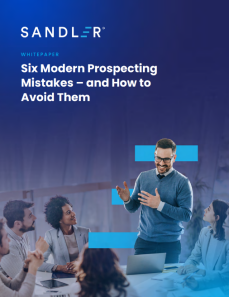
As sales professionals, it’s our job to determine our prospective buyer’s pain. How? By asking the right questions at the right time and in the right way. When we do this, our closing ratios improve. When we don’t, those same ratios get worse. Of course, we all want better closing ratios. That means we will want to start from the position that there is no room in our world for mind-reading.
The trouble is, we often try to read minds without even realizing that’s what we’re doing. If we’ve ever assumed that one buyer’s most important business goal was essentially the same as the situation of the last buyer we spoke to . . . if we’ve ever assumed that Buyer B had basically the same problem as Buyer A, with whom we spoke yesterday . . . if we have ever tried to “turn around” an objection we often get, even though the buyer did not give us that objection . . . we were trying to read minds. And that’s not part of our job description.
Instead of sharpening our telepathy skills, we want to sharpen our questioning skills. Fortunately, two simple, powerful Sandler selling rules can help us do just that.
David Sandler’s first simple rule helps us avoid making assumptions or jumping to conclusions, even intelligently. Here it is: Never answer an unasked question!
Many salespeople love to hear themselves talk and will instantly “fill in the blanks” when intuiting what they believe (with zero evidence) will help the buyer. This is not what professional selling is all about. If we answer a question that has not been asked, we will likely devalue, undermine, or sabotage the entire sale. For example, When someone asks, “How much is it?” – we don’t want to assume they are asking, “Can I get a discount?” They didn’t!
If we “fill in the blanks” by answering a question that has not been asked, we will have no way of knowing what is really on the other person’s mind, and we will be flying blind. We will be out of sync with our prospect.
We only respond to the actual questions on the table, and we only respond once we understand what motivates those questions. If we don’t understand the motivation for a prospect’s question (and we usually don’t), it is our job to get clarification.
So, if we don’t want to read the prospective buyer’s mind . . .
. . . and we don’t want to answer a question that the buyer hasn’t even asked . . .
. . . what do we do to uncover the pain in the buyer’s world?
We follow the second simple Sandler selling rule: Answer every question with a question.
Do you mean literally every question? If someone I am meeting with asks me “How are you today,” do I have to respond by saying, “That’s a great question. Why do you ask?”
Of course not. Understand: This rule is phrased in a way that’s impossible to forget . . . and a little provocative. David Sandler really meant when he formulated this rule that we should use a simple, powerful technique – known as “reversing” – as often as possible, especially in the early stages of the sales discussion. When a prospect asks you a question, reversing helps you uncover the intent behind that question . . . before you try to answer it!
For instance, if someone asks if you can guarantee delivery within the next 30 days, that question may arise for several reasons. Is there an event on the calendar mandating that the delivery must happen within that timeframe? If so, what is it? Has a competitor promised a 30-day delivery standard as the normal turnaround time, and must you meet or exceed that to be considered a vendor? Or is a key person about to leave the organization, meaning the purchasing process will have to begin all over from scratch with someone new thirty days from now?
All of these are possibilities — and there are dozens more. You won’t know what intent lies behind the question unless you say something like, “That’s obviously an important issue. I’m curious. Why do you ask?”
It’s easy to see why Sandler relentlessly emphasized this technique and phrased it as he did. More and better questions equals better information, which equals us doing our job as professionals: uncovering pain.
The two rules you’ve just read about are game-changers, but only if you implement them! Think for a moment of all the advantages of being truly engaged in the conversation by consistently following these rules.
- When you ask questions, the right person (the prospect) is most of the talking.
- Questions shift the pressure from you to the prospect, where it belongs.
- Questions flatter your prospect; they prove you are interested.
- Questions help your prospect solve objections -- or at least see them more clearly.
- Questions help you gather additional information on which you can base your responses.
- Questions probe and illuminate, making it likelier over time that you are both addressing the "real" question.
The highest performers memorize, repeat aloud, and consistently follow these two simple rules. They ask better questions. They have excellent closing ratios. And you can do the same.


